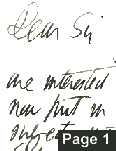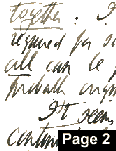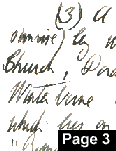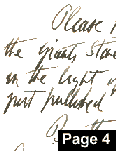



This letter is included in “Republications” for convenience, though it has probably not been published before. Alfred Pope is credited in The Old Straight Track (p. 40) with noticing an early hollow trackway at Dorchester. He is described in Adam Stout’s Creating Prehistory (p. 193) as a friend of Thomas Hardy, twice Mayor of Dorchester, and head of the Eldridge Pope brewery.
In the letter, Watkins mentions his plans for The Old Straight Track, which in the end was published by Methuen in November 1925. The photography at Kenchester, mentioned in the postscript, was for G. H. Jack’s report on the excavations (2 vols., 1916 and 1926).
{1}
5 Harley Court
Hereford
Oct 5th 1924
Dear Sir
I am glad to hear that you are interested in the “Old Straight Track” I have now put in three years strenuous work on the subject, instead of the 5 months work on which I founded the book “Early British Trackways” I have now practically completed a large book on it, much extended especially in regard to Sun Worship alignments and the connection of Beacons with the tracks, but have not yet offered it to a publisher (shall not publish locally this time) But it leaves me in poor health, and especially as regards eyesight which has almost broken down from map work &c. Hence a delay in replying to yours
I do not know Dorsetshire, but had done a little map work from a 1″ “Popular” Ordnance sheet and on one 6″ (quarter) sheet including Bincombe. The great feature of Dorsetshire is the groups of tumuli so near {2} together. It seems obvious that all are not required for sighting purposes (in my own district all can be found to line up, and all were probably originally sighting mounds)
It seems certain that burial in mounds continued long after the sighted tracks went out of use, and the mounds continued to be placed in “honoured positions” on or near an alignment. But the multiplicity of tumuli in a district makes the “accidental coincidence” argument a forcible one
I have only done some very elementary rough work on the Dorchester map, and can’t do more now on account of sight
But I see on the map leys as follows (all require verification from local survey)
(1) The “Roman Road” past Winterbourne Monkton if extended aligns exactly through the church in the middle of Dorchester, and there are other verifying points on a long ley, it passing thro the centre of Rawlsbury Camp
(2) The East and West Roman Road directed at Dorchester has tumuli, ancient stones and other apparent confirmations on the 1″ map, but this requires confirmation on the 6″.
{3} (3) A remarkable (probably May-day sunrise) ley will be found by joining Tolpuddle Church, Dorchester Church (I dont know the name) and Winterborne St Martin Church, in one straight line which lies on many pieces of confirming bits of road “Roman” and otherwise, and several cross roads
(4) The straight bit of vallum of Maiden Castle on its N.N.E side aligns with a line of 4 tumuli near Winterborne Abbas and goes on through tumuli, cross-roads &c to Powerstock Church.
(5) On my 6″ map I had found that the fairly straight piece of vallum on the N.E side of Chalbury Camp continued as a ley through a striking number of tumuli &c on that map. Afterwards looking at the 1″ map I found that I had already marked the same ley from long distance evidence touching the N.E edge of Maiden Castle, and on through Stagg’s Folly Cross road and lying on a piece of straight road near Evershot station
But my eyes are striking at looking out more of my rough pencil lines on the Dorchester Map
{4} Please keep all the enclosures, the paper on the Giants Stone sunrise alignments can be read in the light of Admiral Somervilles recent paper just published in the Archaeologia
By the way in a photograph of Maumsbury Rings (Dorchester) I noticed that some spire (it might be a new foundation and accidental) aligns with the axis of the amphitheatre, and the line is worth investigation.
Yours truly
Alfred Watkins
Yesterday I was photographing the foundations at Magnae (Kenchester) of the largest Roman building we have yet found in Herefordshire; Mr GCould be read as C, but G is correct. H Jack had concluded the excavation. Today I have to take a day’s rest in bed where this is written.